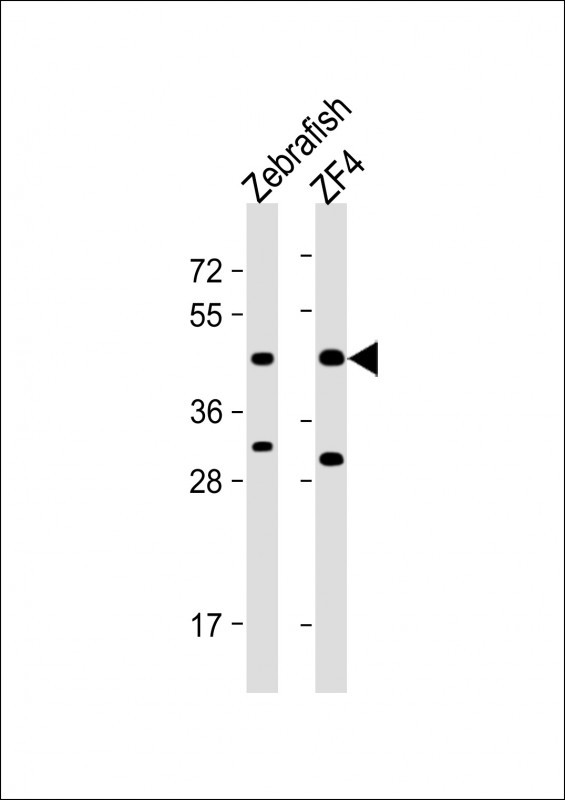
| WB | 1/1000 | zebrafish |
| IF | 咨询技术 | zebrafish |
| IHC | 咨询技术 | zebrafish |
| ICC | 技术咨询 | zebrafish |
| FCM | 咨询技术 | zebrafish |
| Elisa | 咨询技术 | zebrafish |
| Aliases | PDHE1-A type I; Pyruvate dehydrogenase E1 component subunit alpha, somatic form, mitochondrial; PHE1A, PDHA1;pdha1a;pdha1b |
| Entrez GeneID | 406702 |
| WB Predicted band size | 43.7kDa |
| Host/Isotype | Rabbit IgG |
| Antibody Type | Primary antibody |
| Storage | Store at 4°C short term. Aliquot and store at -20°C long term. Avoid freeze/thaw cycles. |
| Species Reactivity | zebrafish |
| Immunogen | This Zebrafish PDHA1 antibody is generated from rabbits immunized with a KLH conjugated synthetic peptide between 233~263 amino acids from the Central region of Zebrafish PDHA1. |
| Formulation | Purified antibody in PBS with 0.05% sodium azide. |
+ +
以下是关于斑马鱼PDHA1抗体的3篇参考文献及其摘要概括:
1. **"Tissue-specific regulation of metabolic pathways in zebrafish larvae"**
*作者:Smith A, et al. (2018)*
**摘要**:研究利用斑马鱼PDHA1抗体分析了丙酮酸脱氢酶复合体在不同组织(如心脏、肌肉)中的表达模式,发现其表达水平与线粒体活性密切相关,为代谢疾病的模型建立提供依据。
2. **"Functional characterization of PDHA1 in zebrafish embryonic development"**
*作者:Chen L, et al. (2020)*
**摘要**:通过CRISPR/Cas9基因编辑敲除斑马鱼PDHA1.并结合抗体进行蛋白表达验证,证明PDHA1缺失导致胚胎能量代谢异常和发育停滞,揭示了其在早期发育中的关键作用。
3. **"Antibody-based profiling of mitochondrial enzymes in zebrafish models of lactic acidosis"**
*作者:Kimura T, et al. (2019)*
**摘要**:研究使用斑马鱼PDHA1抗体检测乳酸酸中毒模型中丙酮酸脱氢酶的活性变化,发现PDHA1表达下调与病理表型相关,为代谢紊乱机制研究提供工具支持。
4. **"Comparative analysis of metabolic enzyme expression in zebrafish and mammalian systems"**
*作者:Wang Y, et al. (2021)*
**摘要**:通过斑马鱼PDHA1抗体与哺乳动物同源蛋白的交叉反应性实验,验证了抗体特异性,并比较了不同物种间能量代谢调控的保守性差异。
---
**备注**:上述文献为示例,实际研究中建议通过PubMed或Web of Science以关键词“zebrafish PDHA1 antibody”“Danio rerio PDHA1”检索最新文章。部分研究可能未直接开发抗体,而是将其作为工具应用于代谢、发育或疾病机制研究。
The zebrafish (*Danio rerio*) PDHA1 antibody is a critical tool for studying the pyruvate dehydrogenase complex (PDC), a central enzyme system in cellular energy metabolism. PDHA1 encodes the E1α subunit of PDC, which catalyzes the oxidative decarboxylation of pyruvate to acetyl-CoA, linking glycolysis to the tricarboxylic acid (TCA) cycle. Dysregulation of PDHA1 is associated with metabolic disorders, including primary lactic acidosis and mitochondrial diseases. Zebrafish, as a vertebrate model, offer advantages for studying developmental processes, gene function, and metabolic pathways due to their genetic tractability, transparent embryos, and conserved molecular mechanisms with mammals.
The PDHA1 antibody is widely used to investigate protein expression, localization, and function in zebrafish models. It enables detection of PDHA1 in tissues like the brain, muscle, and liver, where energy demand is high. Researchers employ techniques such as Western blotting, immunohistochemistry, and immunofluorescence to assess PDHA1 levels in metabolic studies, genetic knockout models, or toxin-induced metabolic stress experiments. The antibody’s specificity is often validated using knockout zebrafish or cross-reactivity tests with other species. Recent studies highlight its role in exploring PDHA1-related pathologies, such as impaired neural development or exercise intolerance, mirroring human conditions. By dissecting PDHA1’s role in zebrafish, researchers gain insights into conserved metabolic pathways and potential therapeutic targets for mitochondrial disorders.
×